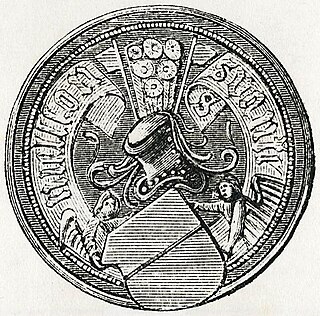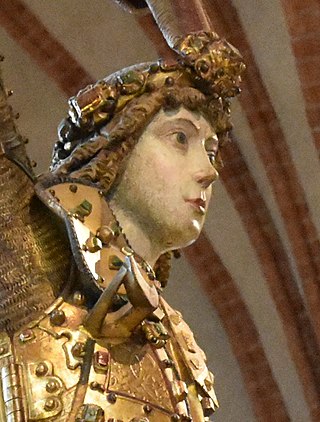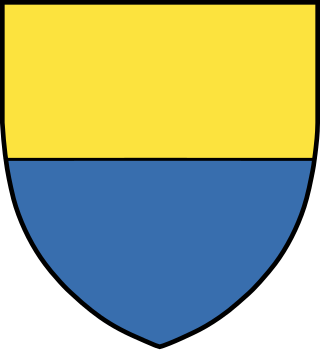
The Kalmar Union was a personal union in Scandinavia, agreed at Kalmar in Sweden as designed by Queen Margaret of Denmark. From 1397 to 1523, it joined under a single monarch the three kingdoms of Denmark, Sweden, and Norway, together with Norway's overseas colonies.

The Stockholm Bloodbath was a trial that led to a series of executions in Stockholm between 7 and 9 November 1520. The event is also known as the Stockholm massacre.

Sten Sture the Younger, was a Swedish nobleman who served as the regent of Sweden, during the era of the Kalmar Union.
Erik Trolle was elected regent of Sweden in 1512, during the era of Kalmar Union. He was Justiciar of Närke and a Lord High Councillor of Sweden from 1487.

Svante Nilsson was a Swedish nobleman and regent of Sweden from 1504 to 1512. He was the father of Sten Sture the Younger (1493–1520), who later served as regent of Sweden during the era of the Kalmar Union.

Sten Sture the Elder was a Swedish statesman and regent of Sweden from 1470 to 1497 and again from 1501 to 1503. As the leader of the victorious Swedish separatist forces against the royal unionist forces during the Battle of Brunkeberg in 1471, he weakened the Kalmar Union considerably and became the effective ruler of Sweden as Lord Regent for most of his remaining life.
Sture was a name borne by three distinct but interrelated noble families in Sweden in the Late Middle Ages and Early Modern Period. It was originally a nickname, meaning 'haughty, proud', but later became a surname. Particularly famous are the three regents from these families who ruled Sweden in succession during the fifty-year period between 1470 and 1520, namely:

Christina Nilsdotter Gyllenstierna of Fogelvik was a Swedish noblewoman. She was married to the Swedish regent Sten Sture the Younger, and led the Swedish resistance against Christian II of Denmark after the death of her spouse. In her own lifetime she was simply referred to as Fru Kristina, but she has become known in history as Kristina Gyllenstierna because of the house of nobility to which she belonged.

The Russo-Swedish War of 1495–1497, known in Sweden as the Stures' Russian War, in Russia First Swedish War, was a border war which occurred between the Grand Duchy of Moscow and the Kingdom of Sweden. Although the war was relatively short, and did not lead to any territorial changes, it has significance as the first war between Sweden and Moscow. Sweden earlier fought wars against the Novgorod Republic, before Novgorod was formally annexed to Moscow in 1478.

Erik Johansson Vasa was a Swedish noble and the Lord of Rydboholm Castle in Roslagen. His son would rule as King Gustav Vasa from 1523–1560.
Eric Bielke, also known as Eerikki Tuurenpoika and Eric Tureson, royal councillor of Sweden, knighted, feudal fiefholder or margrave of Vyborg Castle.
The Lord High Constable was a prominent and influential office in Sweden, from the 13th century until 1676, excluding periods when the office was out of use. The office holder was a member of the Swedish Privy Council and, from 1630 and on, the head of the Swedish Council of War. From 1634, the Lord High Constable was one of five Great Officers of the Realm.
Arvid Birgersson, Lord of Bergkvara was a Swedish magnate and politician in the last decades of Middle Ages. He was justiciar of Östergötland and then of Tiohärad, as well as a Lord High Councillor of Sweden, and once a candidate for Regent. His family coat of arms depict a headless troll whereby some have retrospectively called him Arvid Trolle.

Ingeborg Åkesdotter Tott, in her lifetime called Ingeborg Åkesdotter or simply Fru Ingeborg, was a Swedish noble and the consort of the Swedish regent Sten Sture the Elder. She was the fiefholder of Häme in Finland. She functioned as the de facto queen consort of Sweden for over three decades and participated in state affairs during the reign of her spouse.

The Natt och Dag is a Swedish noble family and the oldest surviving family of pure Swedish extraction, with origins stretching back at least as far as the late thirteenth century. However, the actual name Natt och Dag, alluding to the contrasting colours of its coat of arms, was not coined until the sixteenth century, and was not used as a surname by the family itself until the eighteenth century It is therefore customary to write the name in parentheses when applying it to individuals prior to 1700.
Mette Iversdotter Dyre was a Danish noble, nominal sheriff and chancellor. She was married three times to powerful men: two royal councillors and finally Svante, Regent of Sweden. As such, she was a de facto queen consort. Mette Dyre is credited with political influence on the affairs of state through her spouse.
Anna Eriksdotter Bielke was a Swedish noble, commander of the city and castle of Kalmar during the Swedish rebellion against Denmark.
Ebba Bielke (1570–1618), was a Swedish baroness convicted of high treason.
Ture Turesson (Bielke) (1425–1489/90) was a Swedish statesman and military commander and a prominent leader of the unionist party during the Kalmar Union period. He was a Privy Councillor and Castellan of Axvall Castle during the reign of separatist King Charles Canutesson, before defecting to the unionist side in 1452, spending several years in exile in Denmark. He was appointed Lord High Constable of Sweden, Castellan of Stockholm and Kalmar and Captain-General during the reign of King Christian I, and commanded the unionist forces during several major battles during the turbulent 1460s, before surrendering to Sten Sture the Elder's separatists in 1472. During his later years he was Lawspeaker of the province of Öland.

The Kalmar Bloodbath, sometimes described as the Second Kalmar Bloodbath to distinguish it from an earlier massacre in the same place, was the public mass execution of 22 men in Kalmar, Sweden, on 16 May 1599. All of the victims were members of the garrison from Kalmar Castle, and included three noblemen and a priest, all four of whom were beheaded. The other eighteen victims, comprising secretaries, garrison officers and mercenary commanders, were all hanged.











